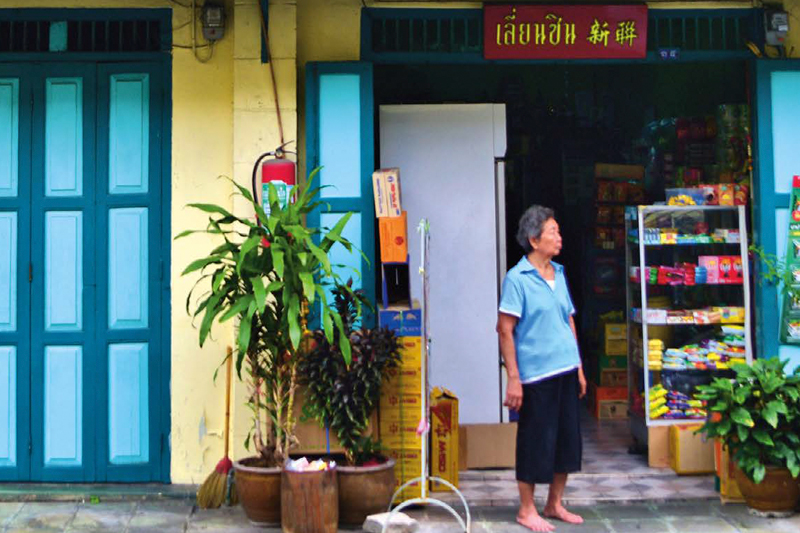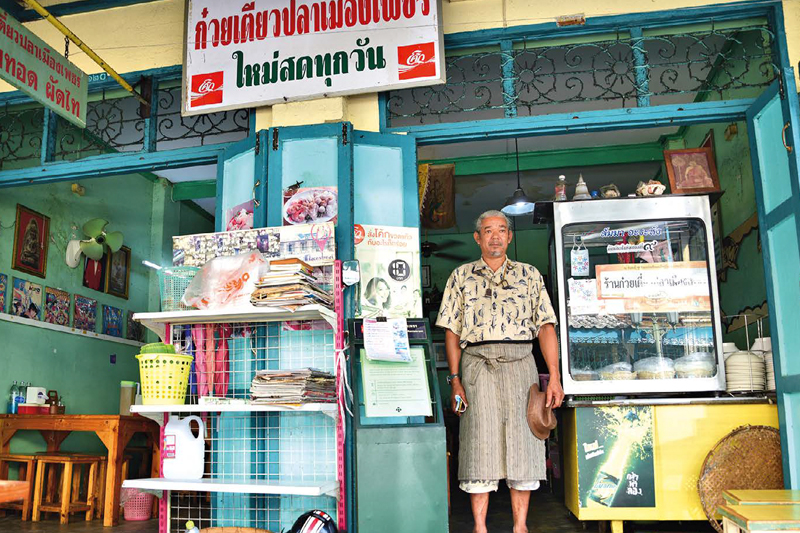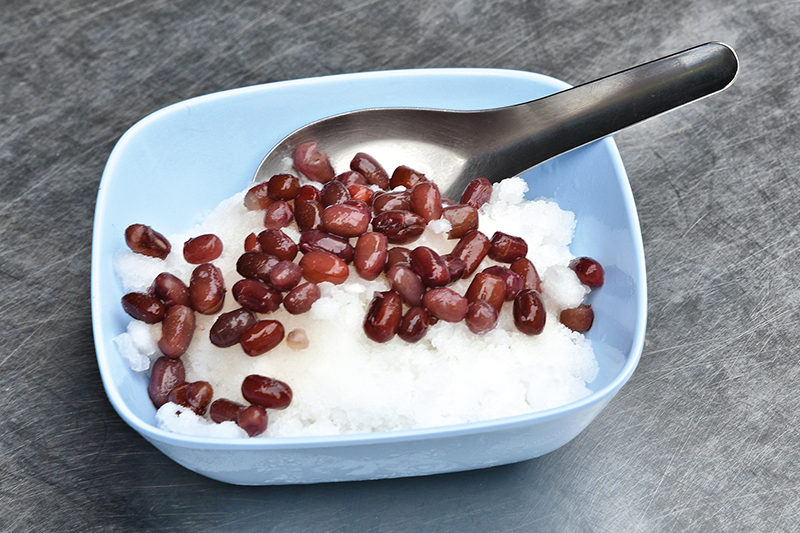
Bangkok’s European Surprise
It may look more European than Siamese, yet the Bangkok neighbourhood of Sam Phraeng is home to an authentic Thai community.
Words Ronan O’ Connell
Photos Ronan O’Connell & Shutterstock
Scattered around the edge of a small park, several Austin cars sit in various states of decay. I notice some are missing windows. Others are missing panels. Each of them has been ravaged by the passage of time. Yet, thanks to their classical curved shaped, these British vehicles from the 1940s and 1950s still boast a faded splendour. The same can be said for the neighbourhood in which they are kept. Sam Phraeng to me is one of the most unique corners of Bangkok, an ageing but beautiful place that hides many intriguing stories.

Located in Bangkok’s oldest area, the royal enclave of Rattanakosin, Sam Phraeng once was the site of three Thai royal palaces. Built in the late 1800s in elegant Sino-Portuguese architecture, the cream-and-green coloured townhouses of Sam Phraeng are now home to a cluster of old-fashioned businesses. Protected from development by the Thai Government, this neighbourhood offers a trip back in time for visitors thanks to its historic architecture and the traditional Thai food on sale here.
Despite being very close to the Grand Palace and Bangkok’s biggest attraction, Sam Phraeng is not on the tourist trail. Travellers could walk past it without even noticing. The neighbourhood is barely mentioned, if at all, in travel guides to Bangkok. It is also tucked away from the area’s busy roads, hidden down narrow side streets. Yet Sam Phraeng was once one of the most important areas in all of Bangkok. It was here, just 300m east of the Grand Palace, that palaces were built for three sons of King Rama IV, with a grand neighbourhood springing up around them.
Lined with dozens of pretty shophouses, embellished by intricately-carved eaves and folding wooden windows, Sam Phraeng became what is widely considered to be Bangkok’s first European-style neighbourhood. What set it apart from other Bangkok suburbs at the time was its Sino-Portuguese style, a striking form of architecture which fuses European and Chinese designs. It quickly became a wealthy area home to upmarket gold and jewellery shops, as well as the workshops of the goldsmiths who work for the Royal Family.
Sam Phraeng is the collective name for the three main roads that run through this area, each named after one of the three princes who had palaces here. Prince Sapphasat Suphakit was the inspiration for Phraeng Sapphasat Road. Prince Narathip Praphanphong lent his name to Phraeng Nara Road, and Prince Bhudhares dhamrongsakdi was the inspiration for Phraeng Phutorn Road, which runs through the middle of the neighbourhood. It was on the latter of these roads that I came across the old Austin cars.
One of the historical quirks of Sam Phraeng is that it was here, on Phraeng Phutorn Road, that Bangkok’s first Driver’s Licensing Office was located, with motorists having to do laps of this road to prove their skill and earn their permit. That office is long gone, as are two of the three palaces built for the princes. Surprisingly, I found the one remaining palace to be in a state of decay. Paint was peeling off its walls and its large balcony sagged under the weight of time. Located on the corner of Phraeng Nara Road and Buranasat Road, Prince Nara Palace is now largely disused and ignored, with its sole tenant being a low office.

Fortunately, most of the Sam Phraeng area is attractive and well maintained, thanks to the efforts of passionate locals like Surasak Hazunkul. As the 55-year-old man sat in the small restaurant his family have run for decades on Phraeng Phuthorn, he told me how the area got a new lease on life. In the late 1980s, local residents with the aid of Government departments launched a major renovation of the neighbourhood. Local tradesmen helped with woodwork and stonemasonry. Residents, meanwhile, took on the less complicated task of painting each of the more than 100 shophouses in uniform colours of cream, dark green and light blue.
Mr. Surasak said residents of Sam Phraeng now took great pride in the attractive appearance of the neighbourhood. They were determined it would not lose its unique heritage. While they had seen the modern apartment buildings sprouting up all over Bangkok, residents here loved the traditional nature of their surroundings and lifestyle. “We have something special here,” Mr. Surasak told me through an interpreter, gesturing towards the small neighbourhood park, where a group of elderly ladies were playing cards in the shade of a Frangipani tree. “We feel lucky. We don’t want this style of life to change only because the rest of the city is changing. And the food here is the best too!”
Ah, music to my ears. I had heard that Sam Phraeng’s food scene was extraordinary. Now, with a swelling hunger after a few hours of exploring the neighbourhood, I was ready to see if the reality matched its reputation. On the advice of Mr. Surasak, I ventured to a nearby restaurant which for the past 62 years has been selling a delicacy not easy to find in Bangkok. I must admit I did not like the sound of pig’s brain soup. But I will try anything once. To my delight, this ancient Chinese recipe was in fact quite nice – a rich broth filled with pork balls, tofu and pig brains. I finished only half of my bowl, not because I didn’t want any more but because I needed to leave space to try other food.
I was spoiled for choice. Among the offerings from Sam Phraeng’s cheap and basic restaurants was aromatic Radna, fried Cantonese noodles, Thai-style Sukiyaki and freshly-made Som Tam salad. I paired this last dish with some Isaan-style grilled chicken, which made for an exquisite combination. But a good meal, for me, is never over until I have satisfied my sweet tooth. Fortunately Sam Phraeng is renowned for its sugary treats. First up was Khanom Buang coconut crêpes from a business that has been serving up this same recipe for about 80 years. then I moved to a shophouse which specialises in the Thai snack KHanom Pang Sangkhaya – fresh bread dipped in a pandan coconut custard.
Finally, I saved the best for last. Ice cream has been my favourite food since I was a kid. So how could I not try several delicious flavours – durian, coconut and mango – at a shop which has been selling its own homemade ice cream for more than 70 years? The interior of Nattaporn Ice Cream store looked like it barely had changed since the days of the three princes. That is just how the owners like it. That is just how the residents of Sam Phraeng like it. That is just how the residents of Sam Phraeng like it. That is just how I like it. Sam Phraeng please never change.

รถออสตินสัญชาติอังกฤษถูกกัดกร่อนจากกาลเวลา แต่ยังคงไว้ซึ่งความงดงามอันเลือนรางเหมือนกับย่านสามแพร่งที่เก่าแก่ไปตามเวลาที่ผันผ่าน แต่กลับมีกลิ่นอายอันเป็นเอกลักษณ์น่าหลงใหลเป็นมุมลับของกรุงเทพฯ ที่รอให้ทุกคนมาค้นหา
ครั้งหนึ่ง ชุมชนสามแพร่งแห่งรัตนโกสินทร์เคยเป็นที่ตั้งของวังถึงสามแห่ง อาคารสถาปัตยกรรมชิโนโปรตุกีสที่สร้างในศตวรรษที่ 18 บัดนี้ได้เปลี่ยนโฉมเป็นย่านธุรกิจแบบเก่า รอให้นักท่องเที่ยวเดินทางย้อนเวลาไปสัมผัสกับอาหารไทยดั้งเดิมที่วางขายทั่วไปในชุมชนนี้
แม้จะอยู่ห่างจากพระบรมมหาราชวังเพียง 300 เมตร แต่สามแพร่งไม่ได้เป็นจุดหมายของนักท่องเที่ยวส่วนใหญ่เท่าใดนัก แทบจะไม่มีใครสังเกตเห็นขณะที่เดินผ่าน ใครจะเชื่อว่าสามแพร่งเคยเป็นที่ตั้งของวังสามแห่งที่รัชกาลที่ 4 ทรงสร้างให้แก่พระราชโอรสทั้งสามพระองค์ พร้อมกับชุมชนที่เติบโตรายล้อม
ร้านรวงเรียงรายประดับด้วยชายคาแกะสลักและหน้าต่างบานพับไม้ ถือได้ว่าเป็นชุมชนสไตล์ยุโรปชุมชนแรกในกรุงเทพฯ เลยก็ว่าได้ ผสมผสานความเป็นยุโรปและจีนเข้าไว้ด้วยกัน เป็นย่านที่เติบโตอย่างรวดเร็ว เต็มไปด้วยธุรกิจทอง อัญมณี รวมไปถึงงานช่างทองที่ถวายงานแก่ราชวงศ์อีกด้วย
ถนนสามสายตัดผ่านชุมชนแห่งนี้จนเป็นที่มาของชื่อ สามแพร่ง ถนนทั้งสามสายได้แก่ ถนนแพร่งสรพพสาตร ถนนแพร่งนภา ถนนแพร่งภูธร เรียกขานตามพระนามของพระราชโอรสทั้งสามพระองค์ ได้แก่ กรมหลวงสรรพศาตรศุภกิจ กรมพระนราธิปประพันธ์พงษ์ และกรมหมื่นภูธเธศธำรงศักดิ์ ตามลำดับ
ความเก๋อีกอย่างหนึ่งของสามแพร่งอยู่ที่ถนนแพร่งภูธรนี้เอง ซึ่งเป็นที่ตั้งสำนักงานสอบใบขับขี่แห่งแรกของประเทศไทย รถออสตินที่กล่าวถึงตอนต้นก็พบได้ที่ถนนสายนี้ ปัจจุบันไม่หลงเหลือสำนักงานนี้รวมถึงวังอีกสองแห่งที่ยังพบเห็นได้เป็นแห่งสุดท้ายคือวังพระนราที่ทรุดโทรมเต็มที สีกำแพงลอกออกมาเป็นแผ่น ระเบียงทรุดลงมาตามกาลเวลา ไม่มีใครใช้งาน ไม่มีใครเหลียวแล

โชคดีที่พื้นที่ส่วนใหญ่ในชุมชนสามแพร่งยังน่าหลงใหลและได้รับการดูแลจากคนในชุมชนอย่างดี เช่น คุณลุงสุรศักดิ์ ชายวัย 55 ปี ที่ดำเนินกิจการของครอบครัวบนแพร่งภูธรมาหลายสิบปี คุณลุงเล่าให้ฟังว่าช่วงปี 2520 คนในชุมชนและรัฐบาลร่วมกันบูรณะชุมชนครั้งใหญ่ ทั้งงานไม้และงานปูน ชาวบ้านช่วยกันทาสีครีม เขียวเข้ม และฟ้าอ่อนแก่ร้านค้ากว่า 100 ร้าน
คุณสุรศักดิ์กล่าวว่า คนในชุมชนภาคภูมิใจและตั้งใจที่จะรักษามรดกทรงเอกลักษณ์ของชุมชนไว้ แม้ว่าจะมีตึกสมัยใหม่สร้างล้อมรอบ “ของดีอยู่กับเราแล้ว” คุณสุรศักดิ์กล่าวพร้อมกับชี้ไปที่กลุ่มคุณยายเล่นไพ่อยู่ใต้ร่วมไม้ในสวน “เราโชคดี เราไม่ต้องการเปลี่ยนวิถีชีวิตของเราเพียงเพราะว่าที่อื่นเปลี่ยน อาหารที่นี่ก็อร่อยที่หนึ่งเลย”
แล้วก็ถึงเวลาที่เราจะตามไปชิมอาหารตามที่คุณลุงบอกไว้ พอได้ยินชื่อเกาเหลามันสมองหมู หลายคนคงเดินถอยหนี แต่ที่ร้านเปิดมาถึง 62 ปี คงต้องมีอะไรดีจนอดลองชิมไม่ได้ และแล้วก็เป็นอะไรที่คาดไม่ถึง เมนูจีนดั้งเดิมอร่อยทีเดียว น้ำต้มเข้มข้น ลูกชิ้นหมู เต้าหู้ และมันสมองหมูเข้ากันจริงๆ
อาหารที่สามแพร่งมีให้เลือกสรรมากมายจนเลือกไม่ถูก ทั้งถูกและอร่อย มีราดหน้าหมี่กรอบ สุกี้ ส้มตำคู่กับไก่ย่าง ล้างปากด้วยขนมเบื้องอันเลื่องชื่อที่ขายมากว่า 80 ปี ยัง ยังไม่หมด ไปต่อที่ที่ขายมากว่า 80 ปี ยัง ยังไม่หมด ไปต่อที่ขนมปังสังขยาหอมกรุ่น แล้วตบท้ายด้วยไอศกรีมทุเรียน มะพร้าว และมะม่วงของร้านณัฐพรไอศกรีม ที่แทบไม่เปลี่ยนไปเลยตั้งแต่สมัยพระโอรสในรัชกาลที่ 4 ทั้งสามพระองค์ ซึ่งเป็นรสชาติแบบที่เจ้าของร้านชอบ ชาวชุมชนสามแพร่งชอบและผู้มาเยือนอย่างเราก็ชอบจนขอให้อยู่อย่างนี้ไปอีกนานเท่านาน
